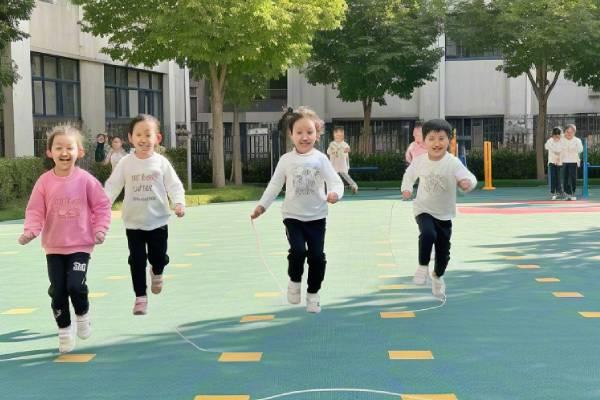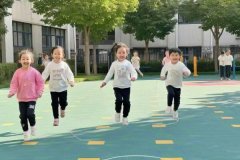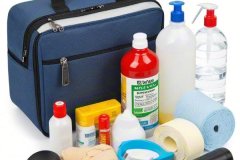Simple fitness activities for children
Here are 10 unique and engaging fitness activities for children designed to spark creativity, coordination, and joy while avoiding common suggestions found online:

1. Animal Obstacle Relay
Create an obstacle course where kids mimic animal movements:
-
Crab walk under a table
-
Frog jumps over pillows
-
Bear crawl across a grassy area
-
Flamingo hops (one-legged) around cones
Benefits: Builds strength, balance, and imagination.
2. Shadow Jump Challenge
On a sunny day, have kids jump to "tag" their own shadows or a partner’s shadow. Add variations:
-
Jump sideways/backward to avoid their shadow.
-
Time how fast they can "stomp" 10 shadow shapes.
Benefits: Enhances agility and spatial awareness.
3. Balloon Volleyball (No Hands!)
Blow up a balloon and create a "net" with a ribbon or string. Kids must keep the balloon airborne using only:
-
Elbows
-
Heads
-
Feet
Benefits: Improves reflexes, teamwork, and motor skills.
4. Nature Balance Beam
Collect fallen branches or use sidewalk chalk to draw winding lines. Challenge kids to:
-
Walk backward/heels-to-toes
-
Carry a small rock or leaf for added difficulty
-
Pretend they’re crossing a lava river!
Benefits: Develops core stability and focus.
5. Musical Freeze & Flex
Play music and have kids dance. When the music stops, call out a fitness pose:
-
"Superhero stance" (wide legs, arms up)
-
"Tree pose" (balance on one leg)
-
"Bridge" (lift hips off the ground).
Benefits: Combines cardio with strength holds.
6. Alphabet Fitness Hunt
Hide letters (written on paper) around a play area. When a child finds a letter, they perform a corresponding exercise:
-
A = 5 Arm circles
-
J = 3 Jumping jacks
-
Z = Zoom like a rocket (sprint 10 steps).
Benefits: Encourages literacy + movement.
7. Towel Tug-of-War
Use soft towels instead of ropes for a safe indoor/outdoor tug-of-war. Add rules:
-
Play on knees to reduce force.
-
Incorporate "freeze breaks" to reset.
Benefits: Builds teamwork and grip strength.
8. Bubble Chase Frenzy
Blow bubbles and challenge kids to:
-
Pop them with elbows/noses (no hands!).
-
Run on tiptoes to "save the bubbles" from hitting the ground.
Benefits: Boosts speed and coordination.
9. Water Cup Relay
Fill plastic cups halfway with water. Kids race to carry them while:
-
Walking sideways
-
Hopping on one foot
-
Balancing cups on their heads (spill = restart!).
Benefits: Combines hydration awareness with motor control.
10. Yoga Storytime
Narrate a short story where kids act out poses:
-
"Climb a mountain" (Mountain Pose)
-
"Slither like a snake" (Cobra Pose)
-
"Fly like an eagle" (Warrior III).
Benefits: Promotes mindfulness and flexibility.
Why These Work
-
Novelty: Avoids generic activities like jumping rope or tag.
-
Low-Cost: Uses household/nature items.
-
Skill Diversity: Targets balance, strength, coordination, and creativity.
-
Adaptability: Adjustable for ages 3–12 and group sizes.
Pair these with upbeat music or storytelling to keep kids engaged while fostering a lifelong love for movement!
Here’s a step-by-step guide to designing original, effective fitness games for kids that prioritize fun, skill-building, and creativity, with unique examples not commonly found online:
1. Define the Core Fitness Goal
Choose a physical skill to target (e.g., balance, agility, strength) and brainstorm playful ways to practice it.
-
Example: For gross motor skills, create a "Lava River Rescue" game where kids jump between "safe rocks" (pillows) to avoid imaginary lava.
2. Incorporate Imaginative Play
Kids engage more when activities feel like adventures. Assign roles, stories, or missions:
-
Example: "Ninja Training Camp" – Kids crawl under "laser strings" (yarn), throw soft balls at targets (cardboard villains), and balance on one leg to "meditate."
3. Use Unconventional Equipment
Avoid standard sports gear. Try household items or DIY tools:
-
Pool noodle "javelins" for throwing practice.
-
Socks rolled into balls for a no-mess indoor toss game.
-
Hula hoops as "magic portals" to leap through.
4. Add Rules That Encourage Movement
Design rules to maximize activity and minimize waiting:
-
No elimination: Instead of sitting out, kids do 5 jumping jacks to rejoin.
-
Team challenges: "Rainbow Scavenger Hunt" – Collect colored objects while crab-walking or hopping.
5. Mix Skill Levels
Adapt for different ages and abilities:
-
Example: "Giant Dice Fitness" – Roll a DIY oversized dice:
-
1 = 10-second plank
-
2 = 3 frog jumps
-
3 = Spin like a tornado (balance challenge)
-
Adjust numbers for younger/older kids.
-
6. Include Surprise Elements
Unexpected twists keep kids engaged:
-
"Freeze & Transform": When music stops, kids freeze and mimic a statue (e.g., superhero, animal).
-
"Mystery Missions": Draw exercise cards from a hat (e.g., "Gallop like a horse to the tree and back").
7. Integrate Cooperative Play
Focus on teamwork over competition:
-
Example: "Bridge Builders" – Teams race to construct a "bridge" (yoga mats or towels) by crawling to carry "materials," then cross it together.
8. Add Sensory Stimulation
Engage multiple senses to boost focus:
-
Sound: Use a tambourine to signal movement changes.
-
Sight: Follow glowing LED balls in a twilight game.
-
Touch: Walk barefoot on grass, sand, or textured mats.
9. Test & Refine
-
Play the game yourself first to spot safety issues or boredom risks.
-
Ask kids for feedback: "Should we add more jumping or crawling?"
Unique Game Ideas (Not Generic!)
-
"Space Explorer Training"
-
Jump over "asteroids" (cushions), crawl through a "spaceship tunnel" (table with blankets), and balance on one foot to "fix a satellite."
-
-
"Dragon Egg Rescue"
-
Carry a water balloon ("dragon egg") in a spoon across an obstacle course. If it drops, do 3 squats to "recharge magic."
-
-
"Shadow Tag 2.0"
-
Use flashlights at dusk; players must avoid their illuminated shadow on the ground by dodging or rolling.
-
Key Principles
-
Safety: Avoid hard surfaces or sharp objects; modify intensity for age groups.
-
Short Rounds: Keep games under 10 minutes to match attention spans.
-
Celebrate Effort: Reward creativity over winning (e.g., "Best Ninja Pose" awards).
Bonus Tip: Involve Kids in Creation
Let them invent their own fitness game rules or themes. For example:
-
"Design a game where we move like our favorite animals – but add a silly exercise penalty if someone laughs!"
By blending imagination with movement, you’ll create fitness games kids beg to play again!





